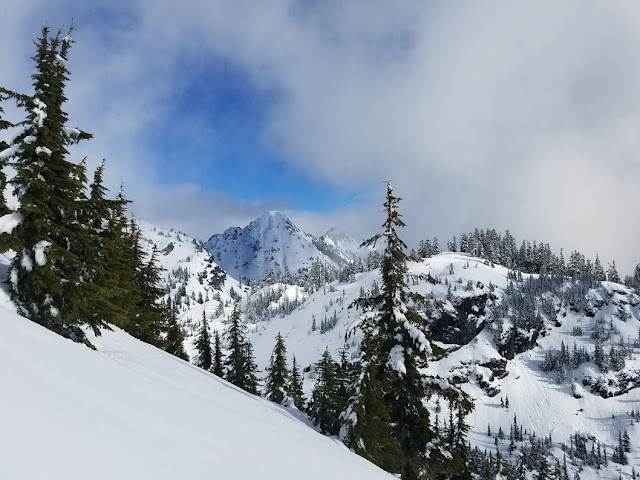Located in the North Cascades, Washington Pass is a beautiful area with towering mountains in all directions. I've done several rock climbs at the pass, including my first alpine route up Liberty Bell in 2016.
 |
| Views of the Liberty Bell group from Washington Pass overlook |
The flying conditions at the pass were looking incredible on August 4th, with thermals forecasted up to 11,000 feet and a very light south wind. There are no dedicated paragliding launches or landing areas at the pass, so it was possible that I would not find an acceptable spot to launch and would need to hike back down. As a south wind day, I figured launching to the south from
somewhere on Hinkhouse Peak would be ideal. With the sun blasting the east and south faces in the morning there were sure to be active thermals by noon.
Hinkhouse was also a good choice because of the large meadow directly below
which seemed to be the only good landing zone at the pass.
 |
| My approximate route up Hinkhouse peak |
 |
| Close-up of scree fields near the summit ridge of Hinkhouse |
After shooting a few scouting shots it looked like there were some scree fields near the ridge that could work for launching. There is no trail up Hinkhouse, so I made my best guess at a convenient route that cut over to a ridge about halfway up. After parking at the observation site, I started hiking around 9am. The hike went well with some bushwhacking down low, but easing off the higher I climbed. Gaining the ridge around 10:30, I dropped the pack to scout out launching spots and bag the summit. Click here for the GPS track.
 |
| Looking down from halfway up Hinkhouse peak with the LZ below |
The ridge was jagged and steep, but there were several large
scree fields directly below that could work for launching. I picked out the best
looking one and went back to retrieve my gear. The launch was challenging with
steep loose rocks for footing and potential for snagged lines. I meticulously
laid out my wing. There were nice strong thermal cycles coming up the slope even before 11am, and it was looking like a great day to fly despite the lack of clouds.
For my launch the wing pulled up clean, but I misjudged the
strength of the cycle, and the wing shot too far forward inducing a
frontal collapse. I quickly recognized this and aborted. Once the wing was back
on the ground, I decided to forward launch while it was still inflated and I
knew the lines were clear. I caught a thermal above the scree field straight out from where I had launched. After
getting up above Hinkhouse the thermal was impressively strong and it only took
8 minutes before I was over 10,000 feet. With plenty of altitude I made the
crossing over to Liberty bell, and then east over Kangaroo Ridge and Silver Star mountain catching
a few strong thermals along the way. My GoPro battery quickly died from the cold and I was only able to record for ~10 second durations for the rest of the flight.
Video from the flight
After getting established above Silver Star I roughly retraced my path back west
and crossed over to Hinkhouse again where I got up to 11,700 feet. I was very
glad that I decided to wear my battery heated gloves or else my hands would have
frozen. I felt a bit dizzy and could tell I was breathing more deeply.
Concerned about the affects of the altitude, I followed the ridge to the west
and felt more normal after dropping to about 9000ft. With the thermals being so
good thus far I kept pushing west, crossing the highway again to get above Frisco Mountain.
I was approaching the limit to where I might not be able to get back to
the landing zone, but I saw a nice looking field next to Lake Ann as I flew over, which
gave me the confidence to keep pushing to the west knowing there was a place I
could land if I got flushed.
Sure enough, after hunting around for a thermal near a ridge south of Black peak, all I found was sink, and I decided to B-line it back to Lake Ann. It was intimidating flying close to the ridges and tall peaks. I’m
glad I made the choice to fly on a very light wind day, otherwise the terrain I
was flying close to could have produced some nasty turbulence. For a link to my Ayvri flight track click here.
After landing next to the lake it was a quick pack up and a
peaceful 1.5 mile hike out on the trail. It only took a few minutes for me to
hitch a ride back to my car and the adventure was complete!















































